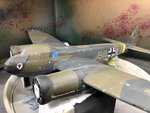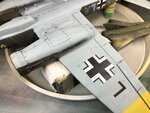Wiking
Airman
Hello all,
Hope everyone is dealing well with covid-19 issues..
Question:
- Has anyone experimented using 'Future' acrylic clear, introducing it in liquid form only directly under each individual decal at the time of application, and not shot over the whole model before applying decals? I wonder if 'Future' works as an adhesive and a pre-emptive anti-silvering solution when it is introduced under the decal at the time of applying it to paint.
BACKGROUND:
I am building a Revell 1/32 Ju-88, airbrushed with Vallero Air paints. It's my first time using an airbrush (Badger double-action). The splinter camouflage masking and airbrushing went well enough. I have finished the colors and am ready for decalling.
- The surface of the paint is not as smooth as I achieve with my old-fashioned bristle-brushing. The surface has a sand-papery 'grain' to it. Maybe I airbrushed the paint too dry and this lead to a build-up of dry paint 'grain' on the surface? I'll research that problem separately. It isn't as apparent when resurfaced with Matte finish, so I will move forward and live with it as a 'lesson learned'.
- I expect this surface 'grain' will lead to decal silvering.
- I shot a sample area of the model with 'Future' acrylic floor clear and the 'grain' doesn't diminish much at all.
- I came here to research the problem and found this discussion thread useful: Silvering.
- I will employ Micro-Set and -Sol and test a few expendable decals to see how to I can handle the situation by trial and error.
But the use of Future many offer a pre-emptive solution. Therefore my question.
Thank you,
- Art


Hope everyone is dealing well with covid-19 issues..
Question:
- Has anyone experimented using 'Future' acrylic clear, introducing it in liquid form only directly under each individual decal at the time of application, and not shot over the whole model before applying decals? I wonder if 'Future' works as an adhesive and a pre-emptive anti-silvering solution when it is introduced under the decal at the time of applying it to paint.
BACKGROUND:
I am building a Revell 1/32 Ju-88, airbrushed with Vallero Air paints. It's my first time using an airbrush (Badger double-action). The splinter camouflage masking and airbrushing went well enough. I have finished the colors and am ready for decalling.
- The surface of the paint is not as smooth as I achieve with my old-fashioned bristle-brushing. The surface has a sand-papery 'grain' to it. Maybe I airbrushed the paint too dry and this lead to a build-up of dry paint 'grain' on the surface? I'll research that problem separately. It isn't as apparent when resurfaced with Matte finish, so I will move forward and live with it as a 'lesson learned'.
- I expect this surface 'grain' will lead to decal silvering.
- I shot a sample area of the model with 'Future' acrylic floor clear and the 'grain' doesn't diminish much at all.
- I came here to research the problem and found this discussion thread useful: Silvering.
- I will employ Micro-Set and -Sol and test a few expendable decals to see how to I can handle the situation by trial and error.
But the use of Future many offer a pre-emptive solution. Therefore my question.
Thank you,
- Art


